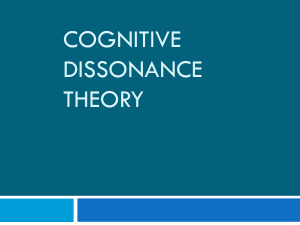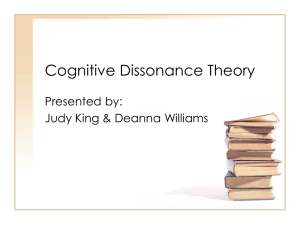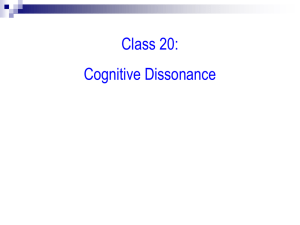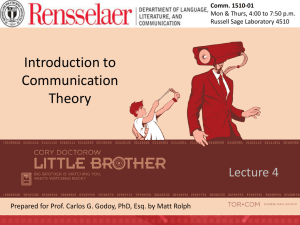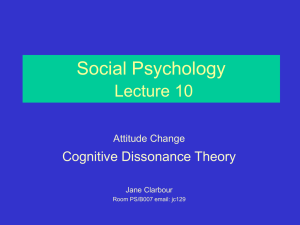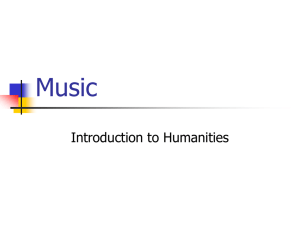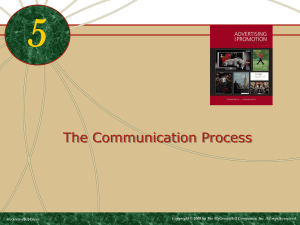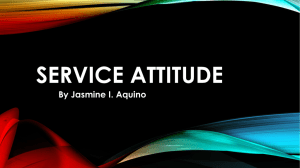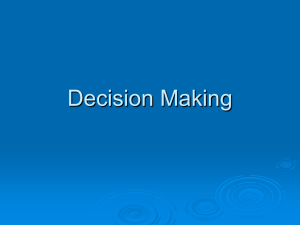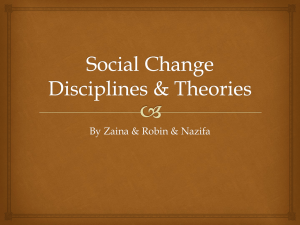Cognitive Dissonance Theory
advertisement
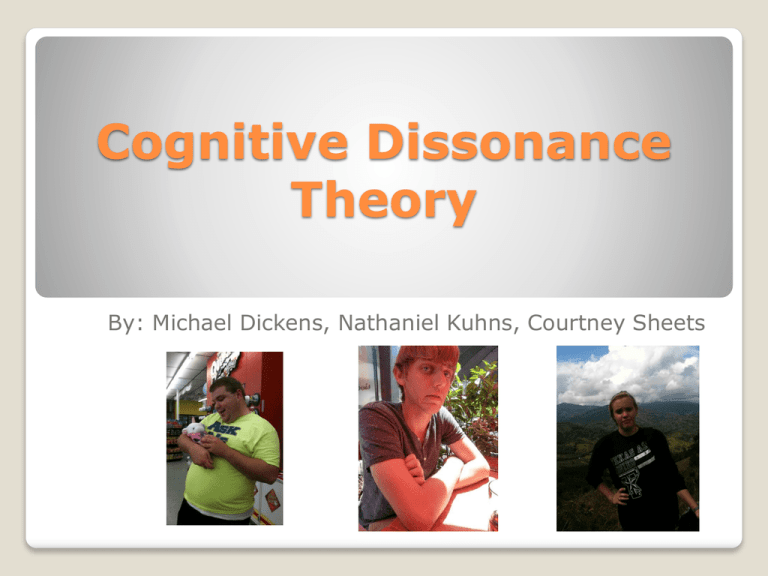
Cognitive Dissonance Theory By: Michael Dickens, Nathaniel Kuhns, Courtney Sheets Author: Leon Festinger 1957 Roots in Psychology Cigarette conflict gave rise to theory ◦ “Coffin Nails” Origins Self-report Objectivist On a scale of 1 to 5 this theory would fall under a 5. Methodology & Epistemology Cognitive= thought Dissonance= conflict “The distressing mental state caused by inconsistency between a person’s two beliefs or a belief and an action. (Griffin 8th ed., 2012) Definition Whenever we behave in a way that is inconsistent a “fierce all consuming drive state” enters your mind and forces you to make a change in order to relieve that state. (Eidenmuller, 2012) Definition cont. “A person’s conflicting thoughts or ideas which directly cause changes in behavior or attitudes associated with those thoughts or ideas.” (Dickens, Kuhns, & Sheets, 2013) Definition cont. One afternoon a fox was walking through the forest and spotted a bunch of grapes hanging from over a lofty branch.” Just the thing to quench my thirst," quoth he. Taking a few steps back, the fox jumped and just missed the hanging grapes. Again the fox took a few paces back and tried to reach them but still failed. Finally, giving up, the fox turned up his nose and said, "They're probably sour anyway," and proceeded to walk away. Fox and the Grapes Selective Exposure – The tendency people have to avoid information that would create cognitive dissonance because its incompatible with their current beliefs. Reduction of Dissonance Post decision dissonance – strong doubts experienced after making an important, close-call decision that is difficult to reverse. (This is a type of dissonance, but it is suggestive of a person who can predict their future dissonance and thus changes their current behavior.) Reduction of Dissonance cont. Minimal Justification – a claim that the best way to stimulate an attitude change in others is to offer just enough incentive to elicit counterattitudinal behavior. Reduction of Dissonance cont. (Additional): Try to acquire new information that will increase the harmony Change one or more beliefs associated with the dissonance Reduce the importance that caused this dissonance Reduction of Dissonance cont. A • Attitude/ Behavior inconsistency Linear Model (A) B • Dissonance Created Linear Model (B) C • Attitude Change Linear Model (C) D • Dissonance Reduced Linear Model (D) A B C D • Attitude/ Behavior inconsistency • Dissonance Created • Attitude Change • Dissonance Reduced Linear Model Compliance Counterattitudional Advocacy Dissonance Thermoator Concepts Falsifiability Measurable Data Observe-ability Self-Perception Theory Criticism & Competing Theories 1. Which statement creates Cognitive Dissonance? a) b) c) d) I want to sing, and I have the voice of an angel. I really need a band-aid, and there is one in my pocket. I have to have an orange, but I am allergic to Vitamin C. We want to go get a hamburger, and we have just enough money to do so. Questions 1. Which statement creates Cognitive Dissonance? a) b) c) d) I want to sing, and I have the voice of an angel. I really need a band-aid, and there is one in my pocket. I have to have an orange, but I am allergic to Vitamin C. We want to go get a hamburger, and we have just enough money to do so. Questions 2. Out of these definitions, which is closest to the definition provided by the book? a) b) c) d) An uncomfortable feeling caused by holding conflicting ideas simultaneously. The distressing mental state caused by inconsistency between a person’s two beliefs or a belief and an action. Two polar opposite mental feelings caused from a behavior and an attitude. A person’s conflicting thoughts or ideas which directly cause changes in behavior or attitudes associated with those thoughts or ideas. Questions 2. Out of these definitions, which is closest to the definition provided by the book? a) b) c) d) An uncomfortable feeling caused by holding conflicting ideas simultaneously. The distressing mental state caused by inconsistency between a person’s two beliefs or a belief and an action. Two polar opposite mental feelings caused from a behavior and an attitude. A person’s conflicting thoughts or ideas which directly cause changes in behavior or attitudes associated with those thoughts or ideas. Questions 3. Which statement(s) would cause the least amount of Cognitive Dissonance? I want to hang out with Courtney, but she is in Spain. b) I need my phone, but it’s upstairs and I am downstairs. c) I have to make an ‘A’ on my test, but I didn’t study very much d) I want some water, but I am in the desert. a) Questions 3. Which statement(s) would cause the least amount of Cognitive Dissonance? I want to hang out with Courtney, but she is in Spain. b) I need my phone, but it’s upstairs and I am downstairs. c) I have to make an ‘A’ on my test, but I didn’t study very much d) I want some water, but I am in the desert. a) Questions 4. How many hypotheses are there in the reduction of Cognitive Dissonance? 4 b) 1 c) 6 d) 3 a) Questions 4. How many hypotheses are there in the reduction of Cognitive Dissonance? 4 b) 1 c) 6 d) 3 a) Questions 5. Which of the following is not a hypothesis of reducing Cognitive Dissonance? Expectancy Violation b) Selective Exposure c) Minimal Justification d) Postdecision Dissonance a) Questions 5. Which of the following is not a hypothesis of reducing Cognitive Dissonance? Expectancy Violation b) Selective Exposure c) Minimal Justification d) Postdecision Dissonance a) Questions 1._________ and _________ must be present to have Cognitive Dissonance. 2. ________________ is the act of publicly urging someone to believe or do something that is ________ to what the advocate actually believes. 3. ‘The tendency people have to avoid certain information that would create Cognitive Dissonance is known as _______________ Fill in the Blank 1. A Behavior and an attitude must be present to have Cognitive Dissonance. 2.Counterattitudinal advocacy is the act of publicly urging someone to believe or do something that is opposed to what the advocate actually believes. 3. ‘The tendency people have to avoid certain information that would create Cognitive Dissonance is known as selective exposure Fill in the Blank 4. The ________________ claims that we determine our attitudes the same way outside observers do. 5. ____________ Dissonance is when a person has strong doubts after making an important or close-call decision that is difficult to reverse. Fill in the Blank 4. The Self-perception theory claims that we determine our attitudes the same way outside observers do. 5. Post decision dissonance is when a person has strong doubts after making an important or closecall decision that is difficult to reverse. Fill in the Blank 1. A woman has an abortion, but believes that murder is a sin. 2. A child is starving on the streets with no where to go, so he steals a loaf of bread from a gas station. 3. A son tells his mom that she is beautiful after she is injured in a fire, and the son truly believes this. 4. A kid gets punched by a bully on the playground, so the kid hit him back because that is what he was taught. Claims http://1.bp.blogspot.com/_mdzxy-KaZE8/S68UYP6fP7I/AAAAAAAAAHE/DNU0i_6tJTg/s1600/leonfestinger-pic.jpg (Picture) Aesop's fables. (n.d.). Retrieved from http://www.umass.edu/aesop/content.php?n=10&i=1 Sources

